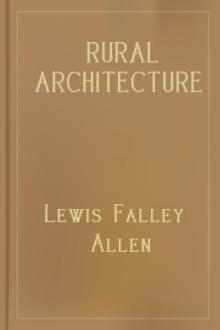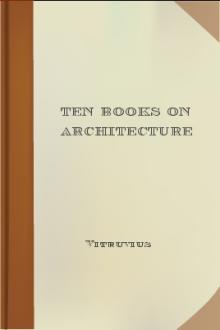Rural Architecture, Lewis Falley Allen [8 ebook reader .txt] 📗

- Author: Lewis Falley Allen
- Performer: -
Book online «Rural Architecture, Lewis Falley Allen [8 ebook reader .txt] 📗». Author Lewis Falley Allen
There is one kind of color, prevailing to a great extent in many parts of our country, particularly the northern and eastern, which, in its effect upon any one having an eye to a fitness of things in country buildings, is a monstrous perversion of good taste. That is the glaring red, made up of Venetian red, ochre, or Spanish brown, with doors and windows touched off with white. The only apology we have ever heard given for such a barbarism was, that it is a good, strong, and lasting color. We shall not go into an examination as to that fact, but simply answer, that if it be so, there are other colors, not more expensive, which are equally strong and durable, and infinitely more tasteful and fitting. There can be nothing less comporting with the simplicity of rural scenery, than a glaring red color on a building. It connects with nothing natural about it; it neither fades into any surrounding shade of soil or vegetation, and must of necessity, stand out in its own bold and unshrouded impudence, a perfect Ishmaelite in color, and a perversion of every thing harmonious in the design. We eschew red, therefore, from every thing in rural architecture.
A SHORT CHAPTER ON TASTE.The compound words, or terms good-taste and bad-taste have been used in the preceding pages without, perhaps, sufficiently explaining what is meant by the word taste, other than as giving vague and unsatisfactory terms to the reader in measuring the subject in hand. Taste is a term universally applied in criticism of the fine-arts, such as painting, sculpture, architecture, &c., &c., of which there are many schools—of taste, we mean—some of them, perhaps natural, but chiefly conventional, and all more or less arbitrary. The proverb, "there is no accounting for taste," is as old as the aforesaid schools themselves, and defines perfectly our own estimate of the common usage of the term.
As we have intended to use it, Webster defines the word taste to be "the faculty of discerning beauty, order, congruity, proportion, symmetry, or whatever constitutes excellence; style; manner with respect to what is pleasing." With this understanding, therefore; a fitness to the purpose for which a thing is intended—got up in a manner agreeable to the eye and the mind—preserving also a harmony between its various parts and uses; pleasing to the eye, as addressed to the sense, and satisfactory to the mind, as appropriate to the object for which it is required;—these constitute good-taste, as the term is here understood.
The term style, also, is "the manner or form of a thing." When we say, "that is a stylish house," it should mean that it is in, or approaches some particular style of building recognized by the schools. It may or may not be in accordance with good taste, and is, consequently, subject to the same capricious test in its government. Yet styles are subject to arrangement, and are classified in the several schools of architecture, either as distinct specimens of acknowledged orders, as the Doric, the Ionic, the Corinthian, in Grecian architecture, or, the Tuscan and Composite, which are, more distinctly, styles of Roman architecture. To these may be added the Egyptian, the most massive of all; and either of them, in their proper character, grand and imposing when applied to public buildings or extensive structures, but altogether inapplicable, from their want of lightness and convenience, to country or even city dwellings. Other styles—not exactly orders—of architecture, such as the Italian, the Romanesque, the Gothic, the Swiss, with their modifications—all of which admit of a variety of departures from fixed rules, not allowed in the more rigid orders—may be adapted in a variety of ways, to the most agreeable and harmonious arrangement in architectural effect, for dwellings and structures appurtenant to them.
The Italian style of architecture, modified somewhat in pretension and extent, is admirably adapted to most parts of the United States. Its general lightness, openness, and freedom gives a wide range of choice; and its wings, verandas, and terraces, stretching off in any and almost every direction desired, from the main building, make it exceedingly appropriate for general use. The modern, or rural Gothic, branching off sometimes into what is termed the English cottage style, and in many instances blending so intimately with the Italian, as hardly to mark the line of division, is also a beautiful arrangement of building for country dwellings. These, in ruder structures, may also be carried into the Rustic—not a style proper, in itself—but so termed as approximating in execution or pretension to either of the above; while the Swiss, with its hanging roofs, and sheltering eaves may be frequently brought in aid to show out the rustic form in more completeness, and in greater harmony with surrounding objects, than either of the others.
For farm houses, either of these arrangements or departures from a set and positive style, are better fitted than any which we have noticed; and in some one or other of the modifications named, we have applied them in the examples submitted in this work. They may not therefore be viewed as distinct delineations of an order of architecture, or style proper, even; but as a mode appropriate to the object required. And so long as they do not absolutely conflict with true taste, or in their construction commit a barbarism upon any acknowledged system of architecture, in any of its modifications, we hazard no impropriety in introducing them for the imitation of country builders. Congruity with the objects to which it is applied should be the chief merit of any structure whatever; and so long as that object be attained, good taste is not violated, and utility is fully subserved.
Intimately connected with this subject, in rural buildings, is the shape of the structure. Many of the designs recently introduced for the imitation of builders, are full of angles and all sorts of zig-zag lines, which, although they may add to the variety of style, or relieve the monotony of straight and continuous lines, are carried to a needless excess, expensive in their construction, and entail infinite trouble upon the owner or occupant, in the repairs they subject him to, in the leakages continually occurring, against which last, either of wind or rain, it is almost impossible to guard. And what, let us ask, are the benefits of a parcel of needless gables and peaked windows, running up like owl's ears, above the eaves of a house, except to create expense, and invite leakage and decay? If in appearance, they provoke an association of that kind, they certainly are not in good taste; and a foot or two of increased height in a wall, or a low window sufficient for the purpose intended, would give a tone of dignity, of comfort, and real utility, which a whole covey of such pretentious things could not. All such trumpery should be scouted from the dwelling house of the farmer, and left to the special indulgence of the town builder.
A square form of house will afford more area within a given line of wall than any other sensible form which may be adopted. Yet a square house is not so agreeable to the eye as an oblong. Thus, a house should stand somewhat broader on one front than on another. It should also be relieved from an appearance of monotony and tameness, by one or more wings; and such wings should, at their junction with the main building, retreat or advance a sufficient distance from a continuous line, as to relieve it effectually from an appearance of stiffness, and show a different character of occupation from that of the main structure. The front of a house should be the most imposing and finished in its architecture of any one of its parts; and unless some motive of greater convenience control otherwise, its entrance the most highly wrought, as indicating the luxury of the establishment—for even the humblest habitations have their luxuries. The side rooms, or more usually occupied apartments, require less pretension in both architectural effect and finish, and should wear a more subdued appearance; while the kitchen section, and from that, the several grades of apartments stretching beyond it, should distinctly show that they are subservient in their character, and wear a style and finish accordingly. Thus, each part of the house speaks for itself. It is its own finger-board, pointing the stranger to its various accommodation, as plainly as if written on its walls, and saying as significantly as dumb walls can do, that here dwells a well regulated family, who have a parlor for their friends; a library, or sitting-room for their own leisure and comfort; an ample bedroom and nursery, for the parents and the little ones; a kitchen for the cooking; and a scullery and closets, and all the other etceteras which belong to a perfect family homestead.
And so with the grounds. The lawn or "dooryard," should be the best kept ground on the place. The most conspicuous part of the garden should show its shrubbery and its flowers. The side or rear approach should be separated from the lawn, and show its constant business occupation, and openly lead off to where men and farm stock meet on common ground, devoted to every purpose which the farm requires. Such arrangement would be complete in all its parts, satisfactory, and lasting. Tinsel ornament, or gewgaw decoration should never be permitted on any building where the sober enjoyment of agricultural life is designed. It can never add consideration or dignity to the retired gentleman even, and least of all should it be indulged in by the farmer, dwelling on his own cultivated acres.
THE CONSTRUCTION OF CELLARS.Every farm house and farm cottage, where a family of any size occupy the latter, should have a good, substantial stone-walled cellar beneath it. No room attached to the farm house is more profitable, in its occupation, than the cellar. It is useful for storing numberless articles which are necessary to be kept warm and dry in winter, as well as cool in summer, of which the farmer is well aware. The walls of a cellar should rise at least one, to two, or even three feet above the level of the ground surrounding it, according to circumstances, and the rooms in it well ventilated by two or more sliding sash windows in each, according to size, position, and the particular kind of storage for which it is required, so that a draft of pure air can pass through, and give it thorough ventilation at all times. It should also be at least seven and a half feet high in the clear; and if it be even nine feet, that is not too much. If the soil be compact, or such as will hold water, it should be thoroughly drained from the lowest point or corner, and the drain always kept open; (a stone drain is the best and most durable,) and if floored with a coat of flat, or rubble stones, well set in good hydraulic cement—or cement alone, when the stone cannot be obtained—all the better. This last will make it rat proof. For the purpose of avoiding these destructive creatures, the foundation stones in the wall should be brought to a joint, and project at least six inches on each side, from the wall itself, when laid upon this bottom course; as the usual manner of rats is to burrow in a nearly perpendicular direction from the surface, by the side of the wall, when intending to undermine it. On arriving at the bottom, if circumvented by the projecting stones, they will usually abandon their work. Plank of hard wood, or hard burnt bricks, may





Comments (0)